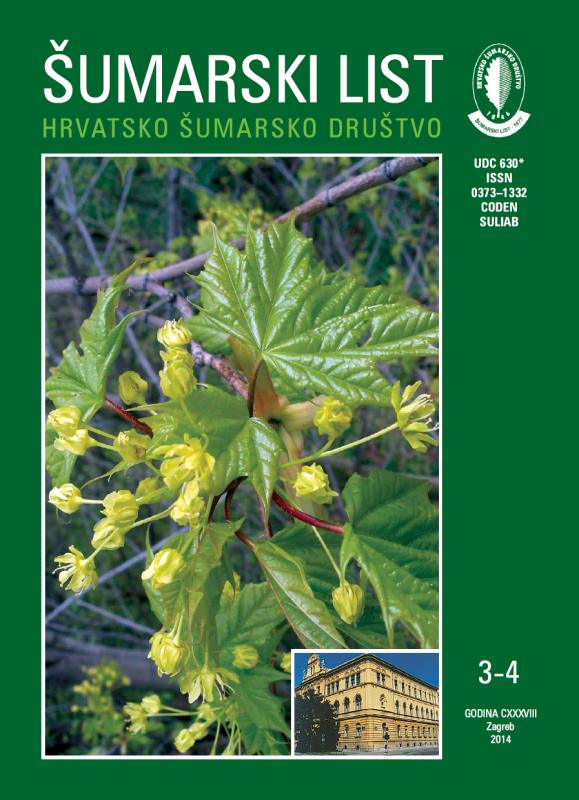
broj: 3-4/2014
pdf (8,09 MB) |
|
||||||||||||||
| RIJEČ UREDNIŠTVA | ||
| Uredništvo | ||
| THE STATUS AND POSSIBILITIES OF A MORE ACCURATE EVALUATION OF FORESTS AND FORESTRY AS PART OF THE ECONOMY OF THE REPUBLIC OF CROATIA pdf HR EN | 121 | |
| IZVORNI ZNANSTVENI ČLANCI | ||
| Jura ČAVLOVIĆ, Krunoslav TESLAK, Karlo BELJAN | UDK 630*569+653+231 (001) | |
| THE EFFECTS OF DIFFERENT STAND REGENERATION PLANNING ON MANAGEMENT AND PEDUNCULATE OAK FOREST DEVELOPMENT – A SMALL SIZE MANAGEMENT CLASS CASE STUDY pdf HR EN | 123 | |
| Dalibor Ballian, Alma Hajrudinović, Jozo Franjić, Faruk Bogunić | UDK 630*164 (Quercus trojana Webb.) (001) | |
| MORPHOLOGICAL VARIABILITY OF THE LEAVES OF THE MACEDONIAN OAK Quercus trojana WEBB.) IN BOSNIA AND HERZEGOVINA AND MONTENEGRO pdf HR EN | 135 | |
| Krunoslav Arač, Milan Pernek | UDK 630*453 (001) | |
| OCCURRENCE AND SPREADING OF THE LARGE LARCH BARK BEETLE (Ips cembrae) IN CROATIA AND POSSIBLITIES OF MONITORING BY USING PHEROMONE TRAPS pdf HR EN | 145 | |
| Maja Popović, Mladen Ivanković, Saša Bogdan | UDK 630* 165 + 181.8 (001) | |
| VARIABILITY OF HEIGHT GROWTH AND SURVIVAL OF PROGENIES FROM PEDUNCULATE OAK (Quercus robur L.) SEED STANDS AT THE FIELD TRIAL ‘JASTREBARSKI LUGOVI’ – FIRST RESULTS pdf HR EN | 155 | |
| Ivana Vitasović Kosić, Mihaela Britvec | UDK 630*187 + 268 (001) | |
| FLORISTIC AND VEGETATION CHARACTERISTIC OF FOREST EDGES AND GRASSLANDS OF ĆIĆARIJA (CROATIA) pdf HR EN | 167 | |
| PRETHODNO PRIOPĆENJE | ||
| Manana Kereselidze, Slavimira Draganova, Daniela Pilarska, Andreas Linde | UDK 630*453 | |
| SUSCEPTIBILITY OF Lymantria monacha AND L. dispar TO THE ENTOMOPATHOGENIC FUNGUS Isaria fumosorosea WIZE pdf HR EN | 185 | |
| Summary Isaria fumosorosea is a cosmopolitan fungal species with a large host range including insects which are economically important pests in agriculture and forestry. In the current study the susceptibility of two forest pests Lymantria monacha and L. dispar to an isolate of the fungus Isaria fumosorosea obtained from Hyphantria cunea and re-isolates from L. dispar, L. monacha and Dendrolimus pini was investigated under laboratory conditions. Newly molted third instar larvae of L. monacha and newly molted second, third and fourth instar larvae of L. dispar were inoculated with fungal conidia by various methods: Larvae of L. dispar were either dipped directly into the conidia suspension (1×108 conidia/ml), or indirect methods were applied – by surface contact of larvae with conidial suspensions (1×108, 1×109, 3×107, 3×108, or 4×108 conidia/ml) placed on filter paper discs in Petri dishes or by contact with oak leaves or larch needles dipped in conidia suspension. Larvae in control variants were treated with water. Mortality of larvae was checked daily for 20 days and the efficacy of the fungus was corrected with mortality in the control treatments. It was found that larvae of both Lymantria – species can be infected experimentally with Isaria fumosorosea. Similar corrected efficacy of Isaria fumosorosea for the third instars larvae of L. dispar (12.37 %) and for L. monacha (12.66 %) was found when 1x108 conidia/ml of the isolate from H. cunea was applied on filter paper. The highest corrected efficacy of Isaria fumosorosea for L. dispar larvae was 60.0 % when 1x109 conidia/ml of the isolate from H. cunea was applied on filter paper. A corrected efficacy of 27.85 % was recorded for L. monacha when 4x108 conidia/ml of re-isolate from L. dispar were applied on larch needles. Our results show that L. dispar and L. monacha larvae are within the psihological host range of the used Isaria fumosorosea isolate from H. cunea and re-isolates obtained from infected larvae of D. pini, L. monacha and L. dispar, however their susceptibility is low. Indirect treatment by surface contact of host larvae with fungal conidia caused higher efficacy of mycosis than dipping into the suspension. Key words: Isaria fumosorosea; Lymantria monacha; Lymantria dispar; bioassays | ||


